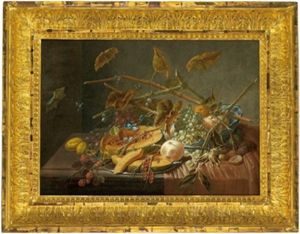Dominicus Gottfried Waerdigh Paintings
Dominicus Gottfried Waerdigh remains an enigmatic figure in the annals of art history, primarily because of the limited documentation and recognition of his contributions during his brief life. Born in 1669, Waerdigh was a product of the 17th century, a period rife with baroque influences and a burgeoning interest in exploring more emotional, dynamic expressions in art. Despite the lack of extensive records, it is understood that Waerdigh was active during a time when European art was experiencing significant transformations, with artists pushing the boundaries of traditional techniques and subjects.
Waerdigh's personal life, including his training and the specifics of his artistic career, is shrouded in mystery. However, it is believed that he was part of the Dutch or Flemish schools, which were prominent in advancing the baroque style, known for its vivid realism, intricate details, and the play of light and shadow. These regional styles were instrumental in depicting not just the physicality of the world but also the emotional and spiritual undertones of human experience.
The brevity of Waerdigh's life, ending in 1689 at the young age of 20, suggests that his output was likely limited and his potential largely unfulfilled. Records of his works are scarce, and any existing pieces may be unattributed or lost to time, making it difficult for art historians to fully assess his style or influence on subsequent generations. Despite these challenges, the mention of Waerdigh in historical art discussions underscores the importance of recognizing even lesser-known artists who contributed to the rich tapestry of art history. His story is a poignant reminder of the many talents that may have shaped the evolution of art in subtle, indiscernible ways, leaving faint traces in the stylistic developments of their time.









